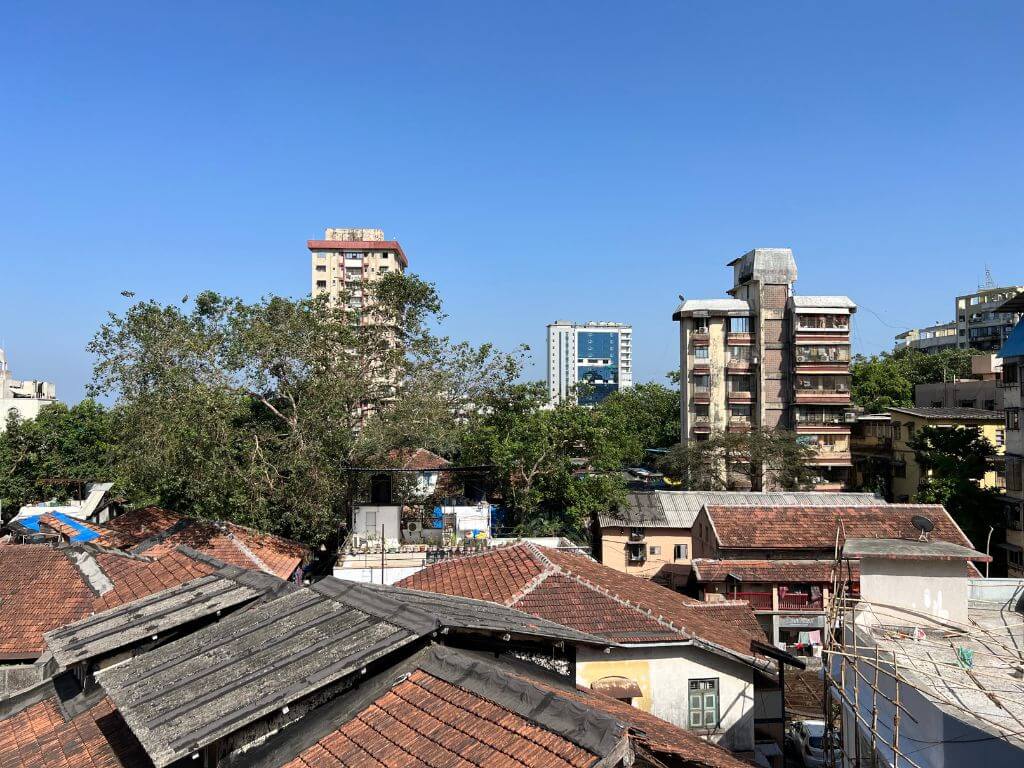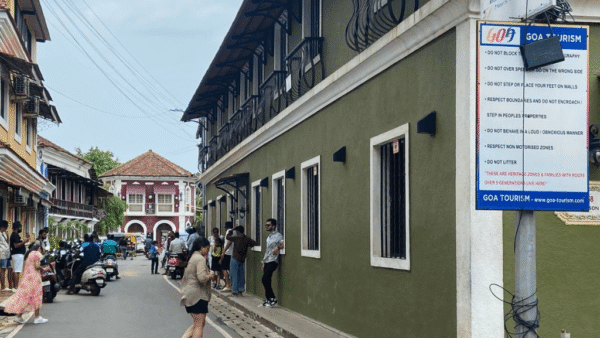Matharpacady is the embodiment of time standing still in fast-paced Mumbai. Situated behind the famous Mazgaon Docks in south Mumbai, the 400-year-old settlement is an entire world enveloped in itself with its quaint Portuguese-style houses, colourful facades, ornate grilles, and open balconies. It is not the structures alone that make Matharpacady distinct, people living here for generations meet and mingle in ways that evoke a sense of deep community bond and shared values. Their concern, in the past few years, has been to stop or stall the scourge of redevelopment from touching even a brick here.
The patches that have yielded to the redevelopment lure, as it slowly but surely made inroads into Matharpacady, stand out like sore thumbs – concrete and glass towers amidst colourful and tiled bungalows. Even if redevelopment is taken as the sine qua non, the essential, in Mumbai’s real estate story, Matharpacady asks two critical questions: Can redevelopment be allowed to simply steamroll a heritage precinct out of existence, should there not be a nod to historically significant areas and cohesive communities in the redevelopment model?
Even as the residents of Matharpacady debated these and related questions, over cups of chai across their balconies, two plots situated opposite each other went under the hammer, the dreaded blue tin sheets were put up, demolitions of the bungalows were heard – painful for the community – and two tall towers in the standard format were up in about two years.
“These towers, Fakhri Apartments and Hermitage Apartments, were built in record time. They are weak and problematic structures that could crumble down if there were to be an earthquake,” says Julius Valladares to Question of Cities. Valladares, in his sixties, has always lived near the Matharpacady Chapel. A narrow opening separates the Chapel from Monarch Apartments which came up behind the erstwhile Matharpacady Club, a well-remembered building which only resides in the memory of people here. Modern buildings sit oddly here surrounded by heritage and history.
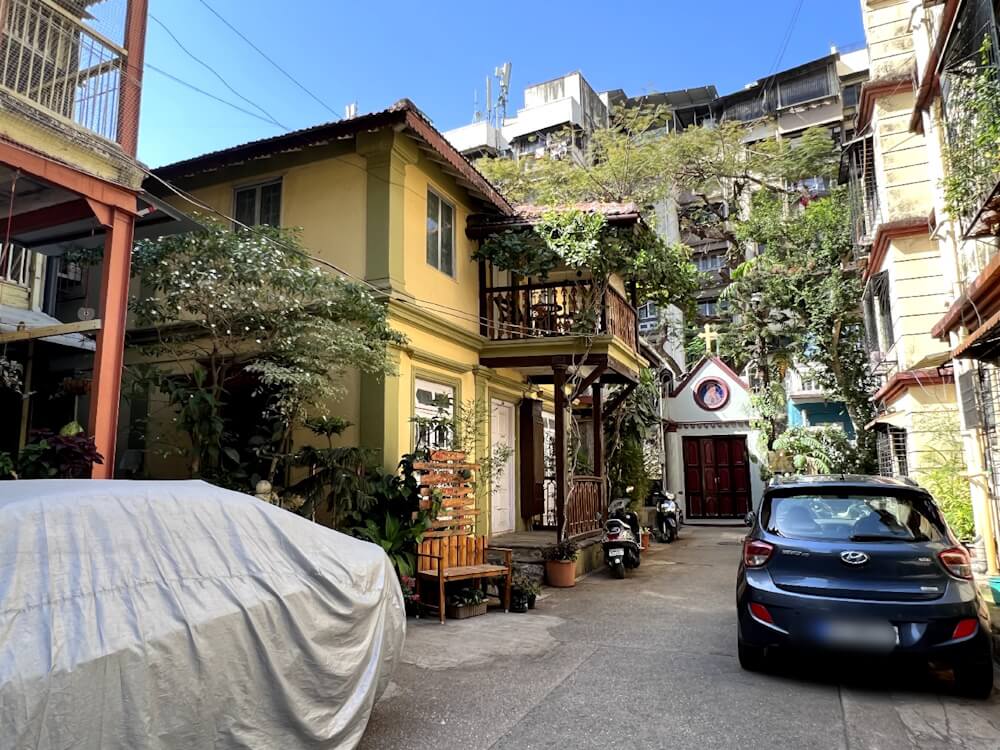
Photo: Maitreyee Rele
The slow structure-by-structure dismembering of Matharpacady has been underway for some years now. “Encroachments on the ‘club street’ as well as high and mid-rise developments on the fringes and within the locality were not in harmony with the scale and character of the precinct’s original built form. There was insensitive reconstruction and facade alterations done by government-run and private agencies. Expensive wooden verandas, trelliswork, and timber structural work was replaced by masonry and concrete work, reducing its architectural merit,” found this study by architect Pankaj Joshi for the Mumbai Metropolitan Region Heritage Conservation Society.[1]
The heritage question
“People have not really come forward to give their consent, if they want redevelopment or not,” says Canute Monteiro, secretary of Matharpacady Residents Welfare Association (MRWA). But the redevelopment model has little patience with the willing consent of a community. Locals say that representatives of builders have been covertly telling them that their neighbours have agreed to redevelopment; a casual chat with old neighbours nails the lie. In one instance, a family found that strangers had walked into their home – many keep their doors open in old-style community living – and started measuring carpet area; they looked like Brihanmumbai Municipal Corporation officials but were working for builders.
“These builders threaten to get their trucks inside to start construction,” says Monteiro with some mirth because the narrow lanes of Matharpacady can barely accommodate ambulances and fire-fighting vehicles. In many cases, redevelopment has been stalled by people not signing off their consent, he explained.
Tragically, what the residents of Matharpacady resisted for years was made easier in May 2022 when the BMC decided to allow the redevelopment of listed heritage Grade III structures and precincts without its approval. This riled the Heritage Committee which called for comprehensive guidelines[2] It may be a little too late.
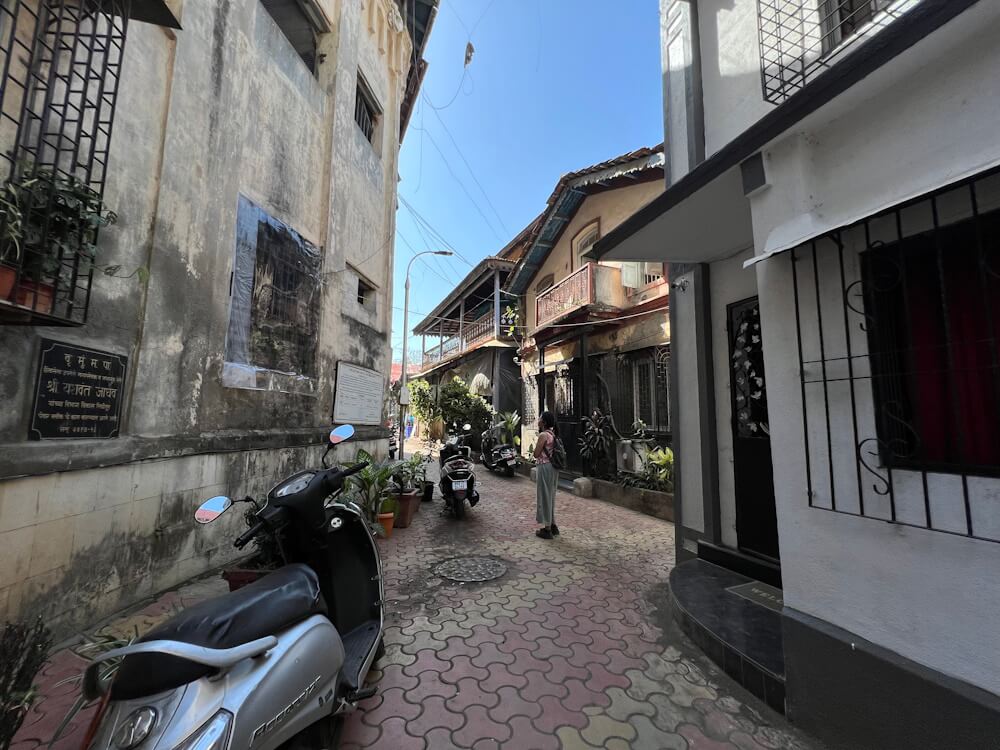
Photo: Maitreyee Rele
Matharpacady gaothan is a heritage precinct as notified by the Heritage Regulations of the Maharashtra Government. This means an expert inter-disciplinary group must decide the kind of redevelopment, based on the Heritage Regulations of 1995. The MRWA has been roping in lawyers and architects to understand what changes are allowed in the precinct and how the overreach can be stopped. Valladares, a member of MRWA, says the residents’ association is now conscious of the fact that Matharpacady will have greater statutory protection if it qualifies for the UNESCO Heritage Status as a number of historical buildings in Mumbai did.
For Matharpacady to acquire this, Dr Aparna Phadke, a researcher from the University of Mumbai’s Geography department, says that there needs to be a registered community which has assembled records and documentation that include the base map of the precinct, a heritage building map, the status of each plot and possible records of ancestors’ presence. This calls for immense patience and meticulous work over months. She and her team have been helping residents but the younger residents are not that keen, she says.
The other side
Those who signed off on the redevelopment, willingly or otherwise, have other tales to tell. Beyond the glamour of living in a high-rise and the convenience of an apartment, they have issues that they had not bargained for – there’s almost no common space for the little things of life such as putting pickles out in the sun, the balconies – where they exist – no longer enable conversations and connections, and so on. Monteiro says that some residents did not realise that moving into an apartment in the redeveloped buildings meant living in smaller houses at higher costs.
The scattered redevelopment has already increased the number of people in Matharpacady putting a severe strain on the narrow roads, parking areas and so on. Hrithvick Deshmukh, also a researcher from University of Mumbai’s Geography department, found that the increase in redevelopment construction had degraded the water quality, affected the drainage system, and the ways in which people access the precinct on foot.
However, there is another side that residents like Mellicent Kurt, 34, who runs an aggregator-based business, point to – the sheer cost and work required to maintain the old structures in the precinct. “It is difficult to renovate or maintain these homes,” she says echoing a few old-timers here. Researchers believe that the restoration and conservation work, expensive if done privately, can be cost-effective if undertaken by authorities such as the BMC or Housing and Urban Development Corporation Ltd (HUDCO).
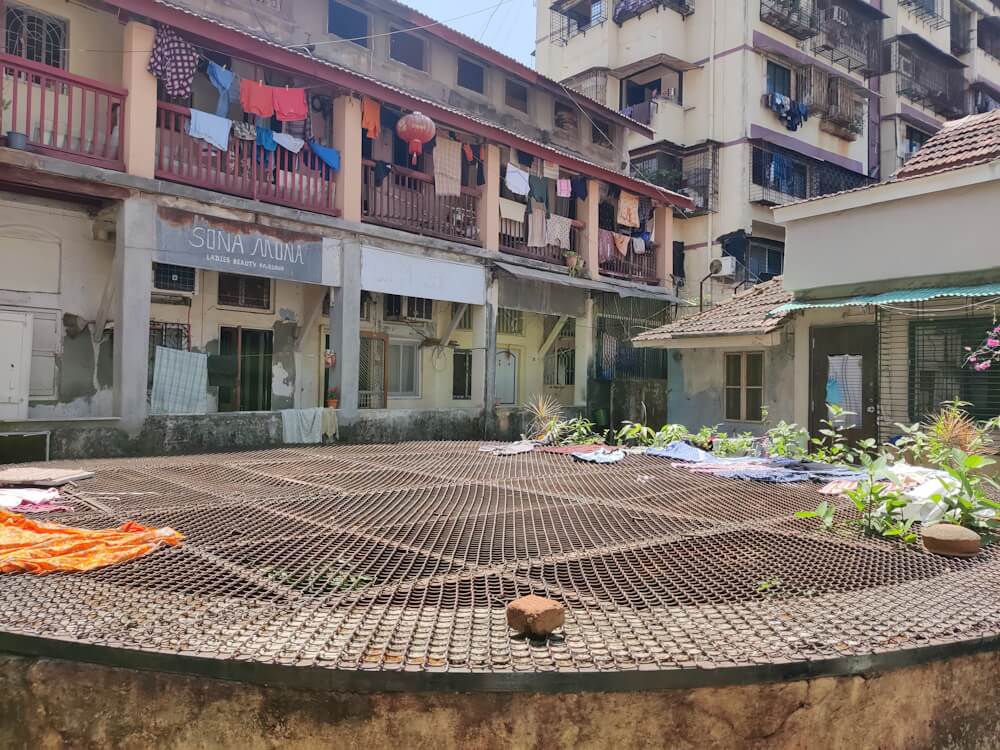
Photo: Jashvitha Dhagey
If Matharpacady has to survive, then the plea of some residents for financial and logistical assistance to maintain their structures, has to be heeded. The burden of conserving the history of a place that holds significance and symbolic value to the city cannot fall on the shoulders of individuals and families. Faced with high maintenance costs and tedious permission processes, many owners of heritage structures prefer to sell the property and plot to builders for redevelopment – even against their will. Also, many houses have old people living by themselves, with children abroad, who seem easy prey for builders. And plot by plot, history gets erased.
The story of Matharpacady
Matharpacady traces its origin, according to records found by Dr Phadke, to a Portuguese owner in the 1700s after which Narrayen Wassodeo appears as the owner. Boards in the gaothan announce Wassodeo’s land lease from 1873; his kin have approached the courts to assert their ownership, says Phadke.
The gaothan has about 300 residents living in its 50-55 houses. Among them, Lion’s Den is a landmark, famous for the two lions guarding its entrance, though the modern guards – CCTV cameras – do the job. A few minutes’ walk from here is the Holy Cross Oratory built in 1875 and dedicated to the saint of infectious diseases which were then rampant in the city. At the local feast known as Navina, nearly 400 people congregate. The shaded and tree-lined lanes, and patches of green around Matharpacady, can make you forget the April heat.
Veteran journalist and historian Rafeeq Baghdadi, who knows the area like the back of his hand, offers minute details such as the window or balcony grills revealing the age of the building. “Can you spot Queen Victoria?” he asks during a walk with us. “If she’s engraved into the design of grills, the house was built when Queen Victoria ruled over India. People paid homage by adding these little details,” he explains.
Matharpacady was also home to one of the most remembered trade unionists of the then Bombay, Joseph Baptista fondly called Kaka Baptista, of the All India Trade Union Congress. Bombay’s first mayor (1948-49), Dr Mafaldo Ubaldo Mascarenhas, lived here too.
The gaothan was part of a tradition in south Mumbai where migrant communities had their koods, or dormitory-like rooms in leased buildings where new migrants from a particular place could live for a few months and find home-like food. Many of Matharpacady’s koods are being brought down; no one lives long enough to care about them. “The koods are mostly shut,” says Monteiro. Its three historic wells lie in a state of ruin too. Despite the slow disintegration of the place, a painter like Sohail Degani, here since 1958, believes it’s still the best place to live.
Why Matharpacady matters
Matharpacady is one of several such gaothans or old villages across Mumbai, many of them in the southern parts but also in the suburbs. Bandra’s gaothans – Sherly Rajan, Kantwady, Waroda, Ranwar, Boran, Pali, and Chuim – house several well-known personalities and enterprises in lanes that are reminiscent of an era gone by.[3] In Andheri East, there’s Kondivita gaothan, nearly erased now by construction that dates back 25 years, Vile Parle has its Francis Pakhady gaothan, and so does Borivali which has Naitodi gaothan. As in Matharpacady, these too are threatened by redevelopment, if not already flattened. Khotachiwadi in Girgaum is among the few to have survived the redevelopment onslaught.
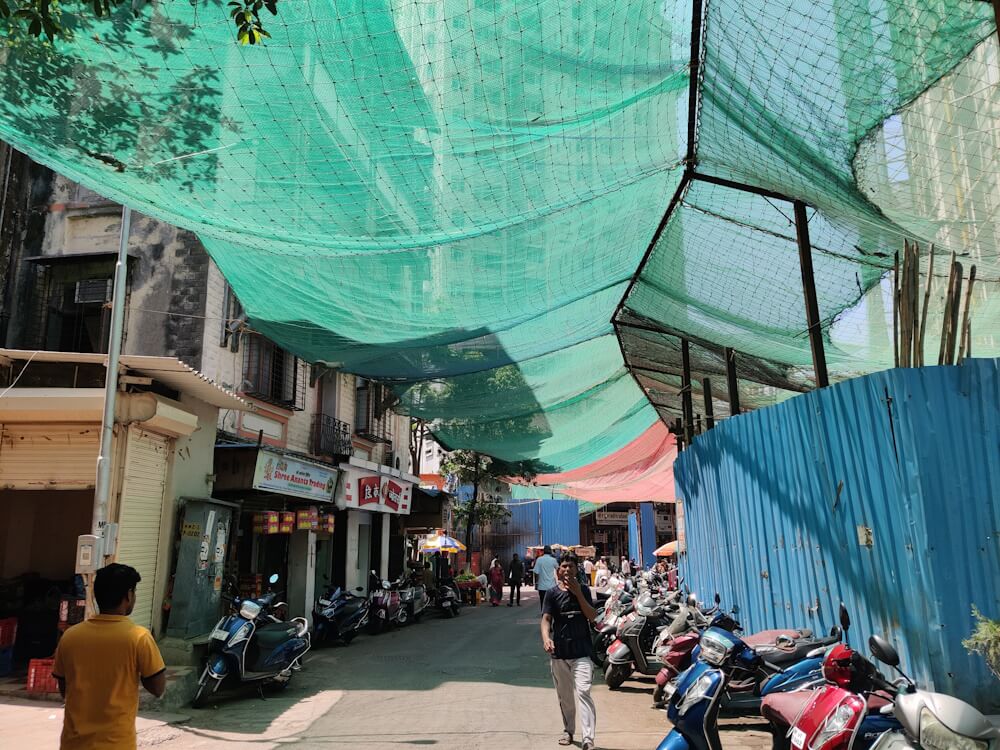
Photo: Jashvitha Dhagey
Most old residents in the gaothans live under the pagdi system of tenancy which is a form of long lease with rights over the house which can be passed on to heirs, but they do not own the land. The rules about redevelopment in the pagdi system are vague. However, the Development Plan 2034 limits the height of structures in the redevelopment of gaothans, koliwadas and adivasi hamlets to 14 metres or four floors, stipulates that the ground coverage of redeveloped structures should not be more than 75 percent to ensure open space, and specifies that using FSI (to build higher) should not affect light and ventilation. The rules for Grade I and II heritage structures are more stringent.[4]
In Matharpacady, a Grade III heritage precinct, some residents are finding new ways to assert its uniqueness. Kurt recently assisted Hrithvick Deshmukh to conduct heritage and biodiversity audits; the latter showed that the area was home to about 215 types of trees and 15 birds. The survey, by Dr Phadke and Deshmukh, showed that nearly half of the 50 houses had retained their original structure. The duo has been holding meetings with the residents’ association so that the 25 houses can be ethnographically studied, signages put up, koods can be restored and opened to people of all faiths, and records of tourists and visitors on heritage walks can be maintained to show Matharpacady’s significance to Mumbai. Residents like Kurt want UNESCO to step in so that “Matharpacady’s beauty and charm will be taken care of” but Dr Phadke recommends that architecture students study the gaothan to put funds to good use, if they are generated.
Khotachiwadi, more popular among tourists, has had a restoration plan with the Khotachiwadi Heritage Trust leading the effort since 1998 when the first house gave way to redevelopment.[5] The project includes the installation of an archway to the precinct, demarcating boundaries, restoring cobblestone pathways, installing street furniture like lamp-posts and benches besides having a wall of fame for the precinct’s famous residents like painter Raja Ravi Varma, and a museum for history enthusiasts.[6]
Khotachiwadi stands out amidst the rash of redevelopment around it. Andrè Baptista, archaeologist and historian whose old bungalow here shares a boundary with a seven-storied building, shortest tall structure in the vicinity, says: “It’s like an ominous tsunami of urban concretisation is coming to engulf my house”. But he criticises the heritage project for “going overboard with Europeanisation” of the place with the cobblestones and all. When tourists come, “people looking into our homes while clicking pictures, it’s like a human zoo,” he rues.
Way forward
In Khotachiwadi, the battle to save the precinct from redevelopment has been an on-going one. In 2010, when House 35 was to make way for a high-rise, some residents filed a case with the assistance of INTACH against the builder which was fought till the Supreme Court. The apex court, like the Bombay High Court, stayed the construction. To save House 28, a 200-year-old bungalow, in 2021, residents used the media to reach the then government but it did not turn out right.[7] “Conservation means we are treading a line between preservation and gentrification,” Baptista says.
Residential heritage structures are difficult to preserve unlike public structures which hold cultural, architectural, even commercial importance to the city. However, the relevance of precincts like Khotachiwadi and Matharpacady can be tied to historical urban narratives of Mumbai as Baptista did during This Ground Plus: Khotachi Wadi in Design Context last year which showed the stories of six families in context of the city.[8]
Away from Matharpacady, the ethnically-cohesive Bhendi Bazaar, largely inhabited by Bohri Muslims, is in the process of a massive redevelopment project helmed by the Saifee Burhani Upliftment Trust. The nearly 250 densely-packed and decrepit buildings across 17 acres are being redeveloped at a total cost of Rs 4,000 crore. The first phase has rehoused 610 families and 128 commercial outlets – in two high-rises[9] bringing the question back to whether there can be alternative types of structures in the redevelopment process.
Matharpacady, like Khotachiwadi and Bhendi Bazaar, is asking questions of Mumbai.
Jashvitha Dhagey is a multimedia journalist and researcher. She developed a deep interest in the way cities function, watching Mumbai at work. She holds a post-graduate diploma in Social Communications Media from Sophia Polytechnic. She loves to watch and chronicle the multiple interactions between people, between people and power, and society and media.
Cover photo: Maitreyee Rele

